The Axon 30 with Under Display Camera: Hands-on Mini-Review
by Andrei Frumusanu on September 3, 2021 9:00 AM EST- Posted in
- Mobile
- Smartphones
- ZTE
- Axon 30
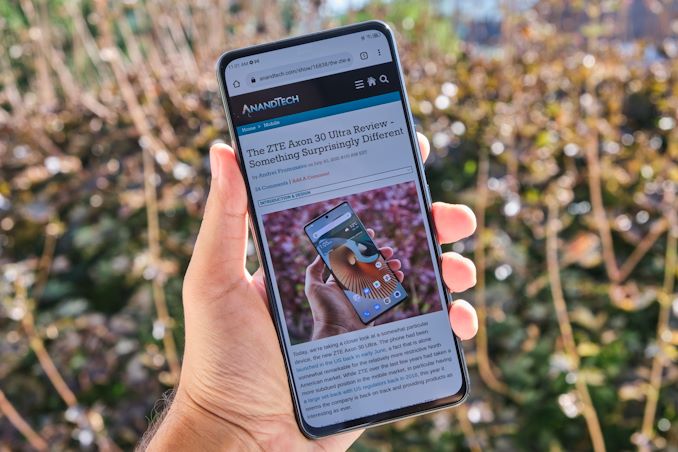
A few weeks ago, ZTE had announced a new device in their flagship line-up, the new Axon 30. The phone is an interesting device for a few reasons: it’s one of the more rare devices this year that opted to use the Snapdragon 870 rather than the newer Snapdragon 888 chip, also pricing itself much more aggressively versus the higher-end Axon 30 Ultra which we reviewed also around a month ago.
What also makes the Axon 30 interesting is the fact that this is now the second-generation under-display camera implementation from ZTE. Although we never had the chance to experience the first-gen Axon 20, we’re now starting to see more vendors attempt to implement the new technology in their new devices, and the Axon 30 is a good opportunity to have a literal closer look at how these under-display cameras work.
| ZTE Axon 30 Series | |||||
| Axon 30 Ultra | Axon 30 | ||||
| SoC | Snapdragon 888 1x Cortex-X1 @ 2.84GHz 3x Cortex-A78 @ 2.42GHz 4x Cortex-A55 @ 1.80GHz Adreno 660 @ 840MHz |
Snapdragon 870 1x Cortex A77 @ 3.2GHz 3x Cortex A77 @ 2.42GHz 4x Cortex A55 @ 1.80GHz Adreno 650 @ ?MHz |
|||
| DRAM | 8/12 GB LPDDR5 | ||||
| Storage | 128/256GB UFS 3.1 | ||||
| Display | 6.67" AMOLED 2400 x 1080 (20:9) 144Hz 300Hz Touch |
6.92" AMOLED 2460 x 1080 (20.5:9) 120Hz 360Hz Touch |
|||
| Size | Height | 161.53 mm | 170.2 mm | ||
| Width | 72.96 mm | 77.8 mm | |||
| Depth | 8.0 mm | 7.8 mm | |||
| Weight | 188 grams | 189 grams | |||
| Battery Capacity | 4600mAh 65W charging (PD3.0) |
4200mAh 65W charging (PD3.0) |
|||
| Wireless Charging | - | - | |||
| Rear Cameras | |||||
| Wide | 64MP IMX686 0.8µm pixels (1.6µm 4:1 16MP) f/1.6 w/OIS 26mm eq. |
64MP IMX686 0.8µm pixels (1.6µm 4:1 16MP) f/1.8 w/OIS 26mm eq. |
|||
| Main | 64MP GW3 0.7µm pixels (1.4µm 4:1 16MP) f/1.9 35mm eq. |
- | |||
| Ultra-wide | 64MP GW3 0.7µm pixels (1.4µm 4:1 16MP) f/2.2 13mm eq. |
8MP f/2.2 13mm eq. |
|||
| Telephoto | 8MP f/3.4 w/OIS (Periscope design) 120mm eq. |
- | |||
| Extra | 5MP Macro 2MP DoF |
||||
| Front Camera | 16MP f/2.5 |
16MP (4MP 2.24µm) f/2.45 |
|||
| I/O | USB-C 3.1 | USB-C 3.0 | |||
| Wireless (local) | 802.11ax WiFi-6E Bluetooth 5.2 LE + NFC |
802.11ax WiFi 6 Bluetooth 5.1 LE + NFC |
|||
| Other Features | Dual Speakers Under-screen optical fingerprint sensor |
Under-screen optical fingerprint sensor | |||
| Dual-SIM | Dual nanoSIM | Dual nanoSIM | |||
| Launch Price | 8+128GB: $749 / £649 / €749 12+256GB: $849 / £739 / €849 |
8+128GB: $499 / €499 12+256GB: $599 / €599 |
|||
The Axon 30 as aforementioned is one of the rare devices this year released with the Snapdragon 870 SoC. As a reminder, the 870 is a higher binned variant of the Snapdragon 865 and 865+, this time increasing the CPU frequency on the fastest Cortex-A77 core to up to 3.2GHz – quite considerably faster than the 2.84GHz of the X1 cores of the Snapdragon 888, and still faster clocked than the 3GHz Snapdragon 888+. Due to the power efficiency regressions or non-progress of the Snapdragon 888’s manufacturing node, the Snapdragon 870 should still be a perfectly viable and competent SoC in a flagship device in 2021.
The device comes in either 8+128 or 12+256GB options, similar to the Axon 30 Ultra. Other device internals of the phone are a bit more conservative versus the Ultra variant, such as the lack of WiFi 6E, only USB 3.0 connectivity, and some notable features lacking such as only a single bottom-firing speaker.
The display is a very large 6.92” AMOLED at 2460 x 1080 resolution. It still features high refresh rate up to 120Hz, but even now increases the touch sampling rate to 360Hz to reduce latency and increase responsiveness.
The phone is extremely large; at 77.8mm width it’s considerably wider than even most “large” devices out there, and definitely dwarfs the Axon 30 Ultra. Because of the quite thin side frame design and curved back glass, as well as the quite thin 7.8mm body, the phone does still manage to have good handling and does feel smaller than what it really is.
The rear of the phone is defined by the camera setup: It’s mostly just a dual-camera device for all practical purposes. The main sensor is the same as on the Axon 30 Ultra, the IMX686 at 64MP resolution which bins down to 16MP 1.6µm in regular shots. The difference here is that the Axon 30 has a smaller f/1.8 aperture optics compared to the Axon 30 Ultra.
Alongside the main camera there’s also a small 8MP ultra-wide unit with f/2.2 optics. There’s also a 5MP macro and a 2MP DoF camera – but these are generally irrelevant for photography in most use-cases. In general, the Axon 30 evidently puts a much lower focus on the camera system than the Axon 30 Ultra.
The phone has one further pratical drawback compared to the Axon 30 Ultra and that is that it’s only featuring a single bottom firing speaker. The Axon 30 Ultra was able to use the earpiece speaker as a stereo unit, and although quality there wasn’t great at least it’s better than just a mono-speaker setup like on the Axon 30.
Naturally, the most interesting aspect of the phone is the fact that it’s one of the very rare devices today with an under-screen camera. While this isn’t ZTE’s first foray into the technology, it’s definitely a much more mature and interesting implementation we’ll be taking a closer look at.
The Axon 30 comes at much cheaper pricing than the Axon 30 Ultra, starting at only $/€499 – which very much puts it well below the usual flagship device price point, so we should adjust our expectations accordingly.


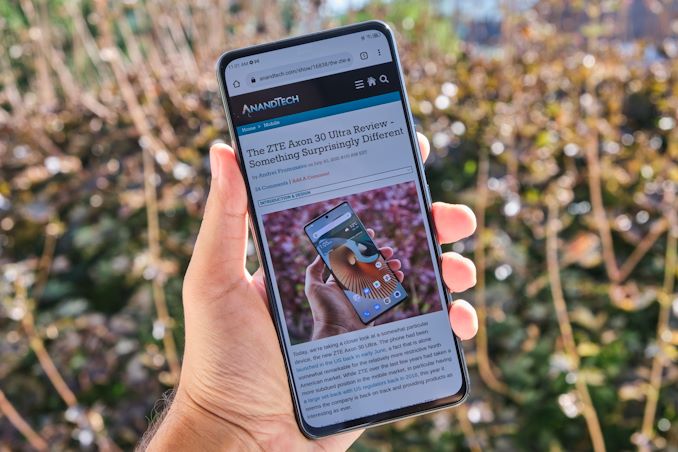
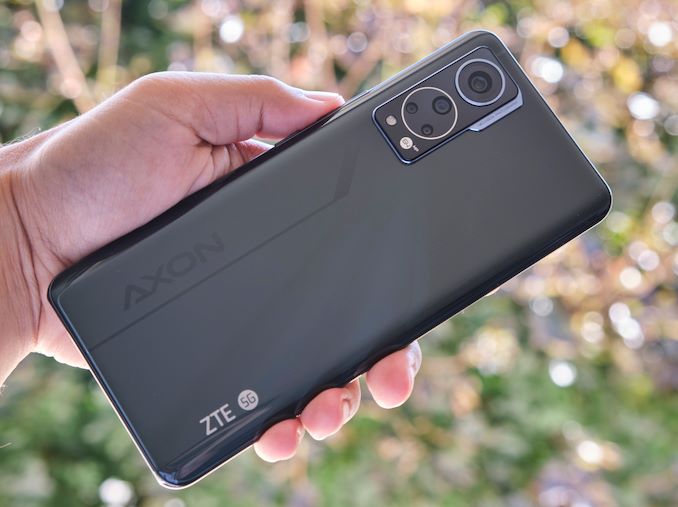
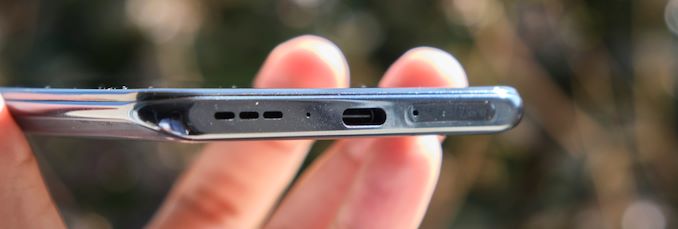
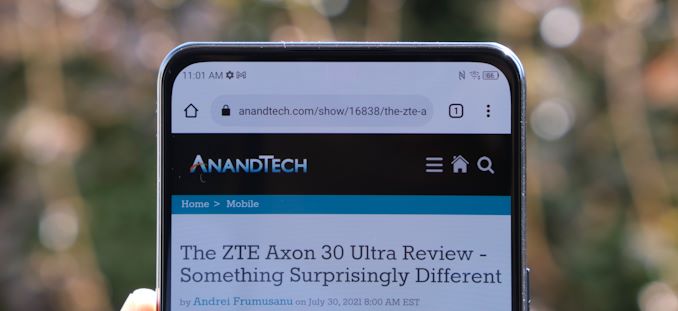








24 Comments
View All Comments
Sharken03 - Tuesday, September 7, 2021 - link
I am certainly going to have UDC on my list for the next phone, so i think you underestimate the interest for this feature.It is the end goal for displays to not show anything but the display and it's getting better each day.
Spunjji - Tuesday, September 7, 2021 - link
They can do that just find by having the camera above the display... then you don't have to have a crap camera.nicmonson - Friday, September 3, 2021 - link
Andrei,Deiter at the Verge hated the under display camera more because of the shimmering it caused on the screen than anything else (see his Fold 3 review). He would have wished just to have a black hole as it tends not to distract.
Do you Andrei find it annoying too? Would you rather just have a black hole if they both magically had the same image quality? Is it any better or worse than the Samsung implementation? Never seen one my self so I am curious about your experience.
Andrei Frumusanu - Friday, September 3, 2021 - link
He's talking about the very low pixel density Fold3 UDC, which has a very different design than the one here. There's no shimmering or anything annoying here beyond noticing that the area is a little brighter.sabot00 - Friday, September 3, 2021 - link
Andrei,Your quite positive Axon 30 Ultra review came out a bit after the July Android Phone recommendation article. Would the Axon 30 Ultra place on that list? I'm thinking specifically about the US and I'm on t-mobile (I heard Verizon is not supported).
Andrei Frumusanu - Friday, September 3, 2021 - link
While that phone was generally positive, I wouldn't recommend it in the guide over an S21/S21+ or even S20+.** A - R ** - Saturday, September 4, 2021 - link
Andrei,I reside in Qatar, & here We have Exynos2100 S21s.
As of now Samsung UAE has officially recalled all the S20 FE Exynos 990 (SM-G780F). Now We Officially have S20 FE 5G & 4G both are SD865, models are SM-G781B & SM-G780G respectively. Our CSC/Product Code is XSG.
My colleague is asking Me to suggest one as an Overall great package in sustained performance of the phone. Which one will be a better choice S21 (E2100) or S21 (E2100) or S20 FE 5G or 4G ? And is there any difference in samsung's ufs 3.1 paired with lpddr5 (uMCP) in 128GB ROM vs 256GB ROM ? as I read itbon their semiconductor site for 128 850MB/s writes & 256/512 1200MB/s.
And personally I'd like to know Andrei, that, what is the Actaul difference between the SM-G781B & SM-G780G ?
What has Samsung done in reality, as I remember Qualcomm mandated 5G Modem with SD865. Now did samsung added it in the g780g with giving no Command via Software or did they entirely removed Qualcomm 5G modem & put their's (Exynos Modem) ?
1az2sx - Sunday, September 5, 2021 - link
Hello Andrey! I'm impressed with the work you've done! And you couldn't pass the Pixel 5 vs. Pixel 4a camera test. Does this image processing chip, which is in the Pixel5, and which is not in the Pixel 4a, do anything.eastcoast_pete - Sunday, September 5, 2021 - link
I am probably the odd one out here, but why not make the selfie cam a (small, maybe 1.5-2 mm) hump that extrudes from the screen, instead of a notch. Having the front camera in a notch also limits what kind of lens setup one can have over that sensor (one does need at least a little distance for those lens elements to work), so, if selfies are really that important, why not owning up to it. Plus, no more notch!Calin - Monday, September 6, 2021 - link
The macro camera is my most used.The camera in the current phone is leaps and bounds above the camera in the previous phone, and yet I prefer to use (and prepare) a 10+ years old DSLR.
However, the macro camera sees a lot of use as a magnifying glass for all that otherwise impossible to read smallprint on basically anything in brick-and-mortar shops.